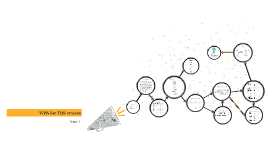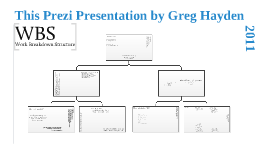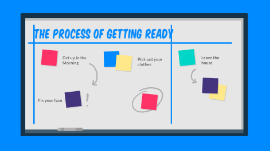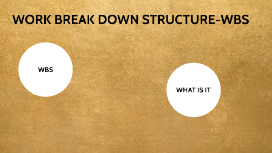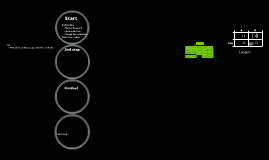WBS
Transcript: Why Do A WBS Divide Project Work Better Manage Project Scope Define and Communicate Scope What A WBS Is and Is Not IS Not - A grouping of tasks IS - A grouping of deliverables IS Not - A schedule IS - A direct reflection of the scope "What isn't in the WBS, is outside of scope" Common Misconceptions The WBS & Schedule are the same because of common tool, MS Project Confusing with work sequencing, no tasks and no dependencies Pre 1996 WBS contained task orientation, no longer recommended Project Scope Mgmt vs Project Time Mgmt Similar look but WBS is not an Organizational Breakdown Structure Other items that have breakdowns, but are not a WBS RBS - Risk Breakdown Structure RBS - Resource Breakdown Structure OBS - Organizational Breakdown Structure CBS - Contract Breakdown Structure BOM - Bill of Materials Understand work at early stages & deliver what is expected Avoid uncontrolled changes & visualize project boundaries and manage complexities Visualize internal and external work & assign and explain the work Provide a baseline for scope change control & achieve a common understanding of the work Enhance project planning & detect early warnings Improve communications & project reporting Gain stakeholder buy-in Monitor, measure and control work better Compare scope among projects Integrate scope with time and cost What could happen if I don't use a WBS Spend more time planning as you discover you missed pieces of work when considering the schedule Project Plan may lack quality Estimating processes may be poor Stakeholder's expectation difficult to manage Run the risk of altering project baselines more often Could face budget overruns as missed work appears Run risk of missing deadlines due to frequent replanning May lose your customer or your credibility When Do I Create a WBS? After the Scope Statement is signed off. Often times this effort may coincide with Business Requirement creation. General Rule CREATE during initiation REFINE during project planning USE to monitor and control during execution VERIFY work at project closing Who should create the WBS? The project manager is the main party Input from other players should be represented How long does it take to do a WBS? General Estimates small / less complex - hours large / more complex - days After taking this valuable time to create a WBS - Baseline & Change Control one component generally the project name major deliverables sub-projects refine deliverables refine further keep going as necessary Experienced WBS creators rarely see more than 175 components. A Quick Review Why do a WBS? Helps divide work and manage/communicate scope Should I do both a schedule and a WBS? Yes, you will then have both what is needed and the how and when it will be delivered When do I create a WBS? After the scope is signed off Who creates the WBS? It is the primary responsibility of the Project Manager What is the appropriate size for the WBS? Size and complexity will be the determining factor It should be decomposed until there is enough detail to estimate time and cost What are the levels of a WBS? of your project This Prezi Presentation by Greg Hayden It depends on the SIZE / size Level 4 Reasons To Use A WBS Decomposition should continue until there is enough detail that one could estimate time and cost as well as monitor the work being done. SIZE / size Level 3 Level 2 It depends on the 2011 "It presents the end vision not the means to accomplish it." WBS Work Breakdown Structure Level 1 A large or critical application may have 6 to 8 levels.







